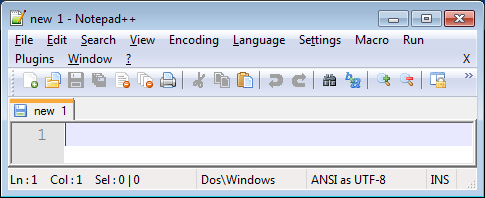
This is again caused by incorrect formatting.
 First bite is U+FFFE (the result of byte-swapping). Unix uses only U+000A (LF) while Windows uses two characters for that: U+000D U+000A (CR+LF) Problem is that line breaks are different between Windows and Unix. For example the file might be formatted as Dos\Windows. It is used by FreeBSD and most recent Linux distributions, including VMware Appliances, as a direct replacement for legacy encodings in general text handling. UTF-8 uses one to four bytes per code point and, being compact for Latin scripts and ASCII-compatible, provides the de facto standard encoding for interchange of Unicode text. File doesn’t use ANSI as UTF-8 encoding. Few common things that can cause a file to be unusable on a linux/VMware Appliance: We have taken the Kerberos configuration file as an example but this can happen with any other file on a Linux system. We will replace it with one edited under Windows with different formatting and encoding and see how this can break Kerberos authentication on the appliance. To illustrate how encoding or malformation can cause an issue, we will be using a nf file on a VMware vRealize Orchestrator Appliance as an example. The full lab logical design can be seen HERE. vCO PowerShell Plugin installed (version 1.945).
First bite is U+FFFE (the result of byte-swapping). Unix uses only U+000A (LF) while Windows uses two characters for that: U+000D U+000A (CR+LF) Problem is that line breaks are different between Windows and Unix. For example the file might be formatted as Dos\Windows. It is used by FreeBSD and most recent Linux distributions, including VMware Appliances, as a direct replacement for legacy encodings in general text handling. UTF-8 uses one to four bytes per code point and, being compact for Latin scripts and ASCII-compatible, provides the de facto standard encoding for interchange of Unicode text. File doesn’t use ANSI as UTF-8 encoding. Few common things that can cause a file to be unusable on a linux/VMware Appliance: We have taken the Kerberos configuration file as an example but this can happen with any other file on a Linux system. We will replace it with one edited under Windows with different formatting and encoding and see how this can break Kerberos authentication on the appliance. To illustrate how encoding or malformation can cause an issue, we will be using a nf file on a VMware vRealize Orchestrator Appliance as an example. The full lab logical design can be seen HERE. vCO PowerShell Plugin installed (version 1.945). 
vCO 5.5.1.0 Virtual Appliance (with FQDN ).
 Windows Server 2008 R2 SP1 (with FQDN ). The following environment has been used in all of the examples below: In particular we will see how malformed nf can break Kerberos authentication on a VMware vRealize Orchestrator Appliance.
Windows Server 2008 R2 SP1 (with FQDN ). The following environment has been used in all of the examples below: In particular we will see how malformed nf can break Kerberos authentication on a VMware vRealize Orchestrator Appliance. 
In this blog post we will look into some use cases that can lead to malformed or wrongly encoded files, which when used on Linux/Unix/VMware Appliances, can break different functionality.
vRO (Add A PowerShell Host) Workflow fails with “cannot locate default realm” error.








 0 kommentar(er)
0 kommentar(er)
